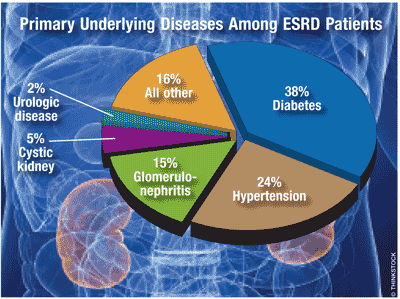US Pharm. 2012;37(6):11.
In 2010, more than 26 million adults had chronic kidney disease (CKD), according to the National Institute of Diabetes and Digestive and Kidney Diseases.

End-Stage Renal Disease (ESRD)
In 2008, it cost about $40 billion to treat more than 500,000 adult ESRD patients with diabetes (37.5%), hypertension, (24.4%), glomerulonephritis (15.2%), or cystic kidney (4.8%) as the primary underlying disease. Of the 70% of ESRD patients who had dialysis, 91.7% and 1% received in-center and home hemodialysis, respectively. Of the remaining patients (26,546 cases), 63.5% and 36.3%, respectively, were administered continuous cycler-assisted and continuous ambulatory peritoneal dialysis.
Kidney Transplants
Diabetes and hypertension were the two most frequent underlying causes of ESRD in all kidney transplants performed in 2009, but the order differed between recipients of transplants from deceased donors and living donors. For deceased-donor transplant recipients, hypertension topped the list (27.8%), followed by diabetes (26%), glomerulonephritis (16.9%), and cystic kidney (11.4%). In living-donor transplant recipients, however, the order of primary causes was glomerulonephritis (22.9%), diabetes (22%), hypertension (19.4%), and cystic kidney (15.6%).
The top three sources of organ donations for kidney transplants were deceased, living, and living-related donors. From 1998 to 2004, the number of adult kidney transplants increased by 34%, living-donor transplants increased by 51%, and deceased-donor transplants increased by 26%; from 2005 to 2008, however, the total number of kidney transplants declined. From 2008 to 2009, despite a 1.4% decline in deceased-donor transplants, a 1.4% increase in transplants occurred that was entirely due to a 6.6% rise in living-donor transplants. Although the largest increase in transplants from 2008 to 2009 was in patients aged 65 years and older (5.6%), transplants in patients aged 18 to 34 years dropped 2.1%.
Most of the increase in 2009 was in women (3.3%, vs. 0.1% in men) and in black patients (4.8%). In 2009, 16,830 waiting-list patients received a kidney transplant (70% [11,765] received a deceased-donor transplant; 30% [5,065] received a living-donor transplant); 5,412 listings were removed because of death. The 2009 increase in living donations was seen in all age groups (highest for patients aged 35-49 years, lowest for those aged 0-17 years), was higher for women, and was highest in Hispanics (12%).The increase in living donors in 2009 versus 2008 was 3.3% for related donors, 8.4% for distantly related donors, 10.4% for spouse/partners, and 6.3% for unrelated donors. One-year (98.6%) and 10-year (76.6%) survival rates were highest for recipients of living-donor transplants. Notably, mortality rates for transplant patients have been dropping since 2005, at a rate of 2.5% per year.
To comment on this article, contact rdavidson@uspharmacist.com.






